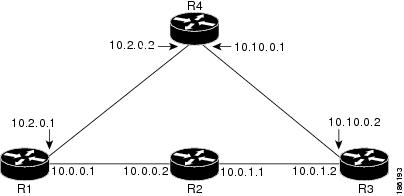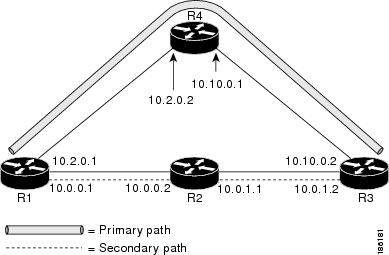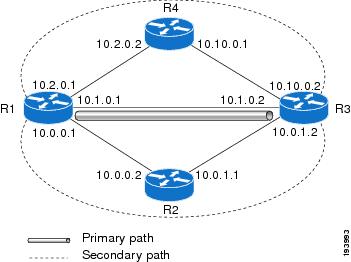autotunnel
mesh
group
--An autotunnel mesh group (referred to as a mesh group) is a set of connections between edge LSRs in a network.
backup
tunnel
--An MPLS TE tunnel used to protect other (primary) tunnels’ traffic when a link or node failure occurs.
BGP
--Border Gateway Protocol. An interdomain routing protocol designed to provide loop-free routing between separate routing
domains that contain independent routing policies (autonomous systems).
Cisco
Express
Forwarding
--A means for accelerating the forwarding of packets within a router, by storing route lookup.
Fast
Reroute
--Procedures that enable temporary routing around a failed link or node while a new LSP is being established at the headend.
graceful
restart
--A process for helping an RP restart after a node failure has occurred.
headend
--The router that originates and maintains a given LSP. This is the first router in the LSP’s path.
hop
--Passage of a data packet between two network nodes (for example, between two routers).
interface
--A network connection.
IS-IS
--Intermediate System-to-Intermediate System. Link-state hierarchical routing protocol that calls for intermediate system
(IS) routers to exchange routing information based on a single metric to determine network topology.
ISSU
--In Service Software Upgrade. The ISSU process allows Cisco IOS XE software at the router level to be updated or otherwise
modified while packet forwarding continues.
link
--A point-to-point connection between adjacent nodes. There can be more than one link between adjacent nodes. A link is a
network communications channel consisting of a circuit or transmission path and all related equipment between a sender and
a receiver. Sometimes referred to as a line or a transmission link.
LSP
--label switched path. A configured connection between two routers, in which label switching is used to carry the packets.
The purpose of an LSP is to carry data packets.
MPLS
--Multiprotocol Label Switching. Packet-forwarding technology, used in the network core, that applies data link layer labels
to tell switching nodes how to forward data, resulting in faster and more scalable forwarding than network layer routing normally
can do.
NHOP
--next hop. The next downstream node along an LSP’s path.
NHOP
backup
tunnel
--next-hop backup tunnel. The backup tunnel terminating at the LSP’s next hop beyond the point of failure, and originating
at the hop immediately upstream of the point of failure. It bypasses a failed link, and is used to protect primary LSPs that
were using this link before the failure.
NNHOP
--next-next hop. The node after the next downstream node along an LSP’s path.
NNHOP
backup
tunnel
--next-next-hop backup tunnel. The backup tunnel terminating at the LSP’s next-next hop beyond the point of failure, and originating
at the hop immediately upstream of the point of failure. It bypasses a failed link or node, and is used to protect primary
LSPs that were using this link or node before the failure.
node
--The endpoint of a network connection or a junction common to two or more lines in a network. Nodes can be interconnected
by links, and serve as control points in the network. Nodes can be processors, controllers, or workstations.
NSF
--Cisco nonstop forwarding. Cisco NSF always runs with stateful switchover (SSO) and provides redundancy for Layer 3 traffic.
NSF works with SSO to minimize the amount of time that a network is unavailable to its users following a switchover. The main
purpose of NSF is to continue forwarding IP packets following a supervisor engine switchover.
OSPF
--Open Shortest Path First. A link-state hierarchical Interior Gateway Protocol routing algorithm, derived from the IS-IS
protocol. OSPF features include least-cost routing, multipath routing, and load balancing.
primary
LSP
--The last LSP originally signaled over the protected interface before the failure. A primary LSP is signaled by configuring
a primary path option.
primary
tunnel
--A tunnel whose LSP may be fast rerouted if there is a failure. Backup tunnels cannot be primary tunnels.
protected
interface
--An interface that has one or more backup tunnels associated with it.
router
--A network layer device that uses one or more metrics to determine the optimal path along which network traffic should be
forwarded. Routers forward packets from one network to another based on network layer information.
RP
--Route Processor. A generic term for the centralized control unit in a chassis.
RSVP
--Resource Reservation Protocol. An IETF protocol used for signaling requests (setting up reservations) for Internet services
by a customer before that customer is permitted to transmit data over that portion of the network.
secondary
LSP
--The LSP that is signaled to provide path protection. A secondary LSP protects a primary LSP.
secondary
path
option
--Configuration of the path option that provides protection.
SRLG
--Shared Risk Link Group. Sets of links that are likely to go down together (for example, because they have the same underlying
fiber).
state
--Information that a router must maintain about each LSP. The information is used for rerouting tunnels.
tailend
--The router upon which an LSP is terminated. This is the last router in the LSP’s path.
TE
--traffic engineering. The techniques and processes used to cause routed traffic to travel through the network on a path other
than the one that would have been chosen if standard routing methods had been used.
topology
--The physical arrangement of network nodes and media within an enterprise networking structure.
tunnel
--Secure communications path between two peers, such as two routers.
VoIP
--Voice over IP. The capability of a router to carry voice traffic (for example, telephone calls and faxes) over an IP network.
Cisco’s voice support is implemented by using voice packet technology.





 Feedback
Feedback